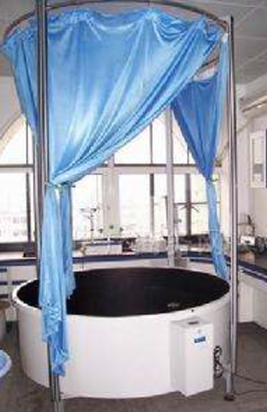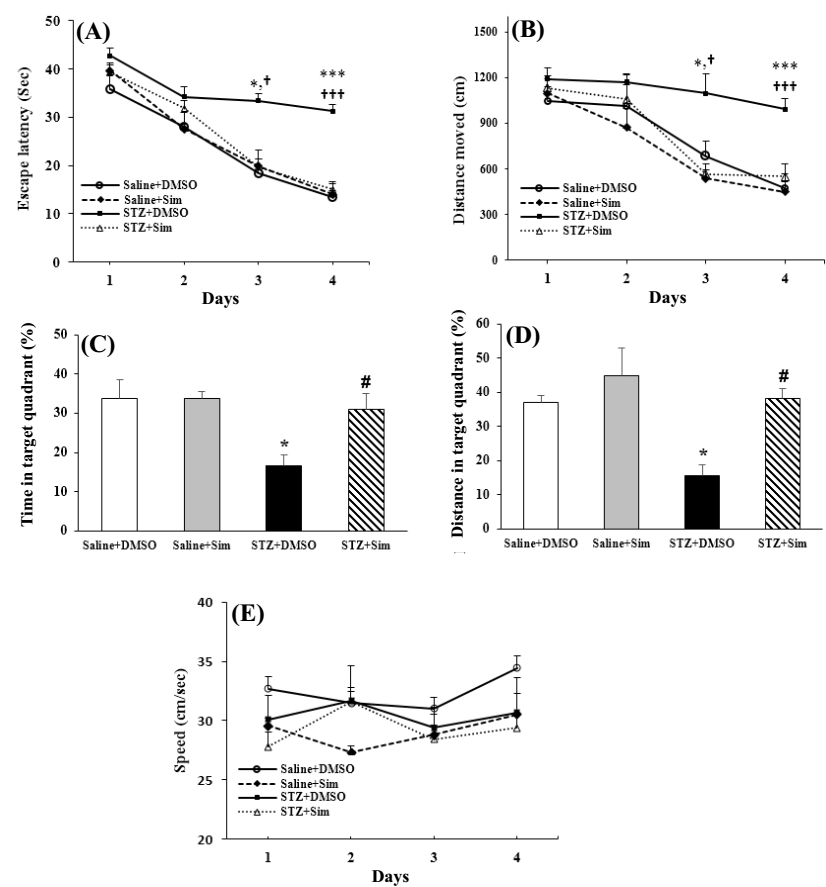Morris Water Maze Test
The Morris water maze is a classic behavioral test of assessing the hippocampal-dependent learning process and spatial memory for rodents. Morris water maze generally includes circular water pool, shade, automatic video recording system and software analysis system. Rodents subjected to Morris water maze have to remember spatial cues to locate the escape platform hidden underwater. Learning and memory function is evaluated by the latency to identify the escape platform and the swimming distance to find the hidden platform. Creative Bioarray offers Morris water maze to evaluate the effects of preclinical drug candidates on cognitive functions of rodent models.
 Figure. 1. Morris water maze
Figure. 1. Morris water maze
We have extensive experience in Morris water maze test to assess learning and memory functions of rodent models, Our service could bolster your research in screening of compounds aimed to treat Alzheimer's disease. Our experts make every effort to design optimized and specific projects to serve our clients.
Study examples
 Fig. 2. Effects of simvastatin (Sim) administration on learning and memory function of rats in Morris water maze test (n = 8 in each group). During place navigation stages on days 17-20 following STZ injection, time taken for the rats to find the platform (a) and total distance traveled (b) in each trial were measured. Percentage of time (c) and distance (d) spent in the goal quadrant (platform area) during probe test is shown in the Figure. There were significant differences between STZ + Sim and STZ + DMSO in distance moved and escape latency during days three and four of place navigation stages. Swimming speed did not change significantly in different groups during four days of place navigation (e). Values are expressed as mean ± SEM. *p ˂ 0.05 and ***p ˂ 0.001 compared with Saline + DMSO group; #p < 0.05 compared with STZ + DMSO group; †p < 0.05 and †††p < 0.001 compared with STZ + Sim group.
Fig. 2. Effects of simvastatin (Sim) administration on learning and memory function of rats in Morris water maze test (n = 8 in each group). During place navigation stages on days 17-20 following STZ injection, time taken for the rats to find the platform (a) and total distance traveled (b) in each trial were measured. Percentage of time (c) and distance (d) spent in the goal quadrant (platform area) during probe test is shown in the Figure. There were significant differences between STZ + Sim and STZ + DMSO in distance moved and escape latency during days three and four of place navigation stages. Swimming speed did not change significantly in different groups during four days of place navigation (e). Values are expressed as mean ± SEM. *p ˂ 0.05 and ***p ˂ 0.001 compared with Saline + DMSO group; #p < 0.05 compared with STZ + DMSO group; †p < 0.05 and †††p < 0.001 compared with STZ + Sim group.
Quotation and ordering
If you have any special needs or questions regarding our services, please feel free to contact us. We look forward to cooperating with you in the future.
Reference
- Adeli S et al. Simvastatin Attenuates Hippocampal MMP-9 Expression in the Streptozotocin-Induced Cognitive Impairment. Iran Biomed J. 2019 Jul;23(4):262-71.
For research use only. Not for any other purpose.
Disease Models
- Oncology Models
-
Inflammation & Autoimmune Disease Models
- Rheumatoid Arthritis Models
- Glomerulonephritis Models
- Multiple Sclerosis (MS) Models
- Ocular Inflammation Models
- Sjögren's Syndrome Model
- LPS-induced Acute Lung Injury Model
- Peritonitis Models
- Passive Cutaneous Anaphylaxis Model
- Delayed-Type Hypersensitivity (DTH) Models
- Inflammatory Bowel Disease Models
- Systemic Lupus Erythematosus Animal Models
- Oral Mucositis Model
- Asthma Model
- Sepsis Model
- Psoriasis Model
- Atopic Dermatitis (AD) Model
- Scleroderma Model
- Gouty Arthritis Model
- Carrageenan-Induced Air Pouch Synovitis Model
- Carrageenan-Induced Paw Edema Model
- Experimental Autoimmune Myasthenia Gravis (EAMG) Model
- Graft-versus-host Disease (GvHD) Models
-
Cardiovascular Disease Models
- Surgical Models
- Animal Models of Hypertension
- Venous Thrombosis Model
- Atherosclerosis model
- Cardiac Arrhythmia Model
- Hyperlipoidemia Model
- Doxorubicin-induced Heart Failure Model
- Isoproterenol-induced Heart Failure Model
- Arterial Thrombosis Model
- Pulmonary Arterial Hypertension (PAH) Models
- Heart Failure with Preserved Ejection Fraction (HFpEF) Model
-
Neurological Disease Models
- Alzheimer's Disease Modeling and Assays
- Seizure Models
- Parkinson's Disease Models
- Ischemic Stroke Models
- Acute Spinal Cord Injury (ASCI) Model
- Traumatic Brain Injury (TBI) Model
- Hypoxic-Ischemic Encephalopathy (HIE) Model
- Tourette Syndrome (TS) Model
- Amyotrophic Lateral Sclerosis (ALS) Model
- Huntington's Disease (HD) Model
- Intracerebral hemorrhage (ICH) Models
- Schizophrenia Model
- Pain Models
-
Metabolic Disease Models
- Type 1 Diabetes Mellitus Model
- Type 2 Diabetes Mellitus Model
- Animal Model of Hyperuricemia
-
Nonalcoholic Fatty Liver Disease Model
- High-Fat Diet-Induced Nonalcoholic Fatty Liver Disease (NAFLD) Model
- Methionine and Choline Deficient (MCD) Diet-Induced Nonalcoholic Fatty Liver Disease (NAFLD) Model
- Gubra-Amylin NASH (GAN) Diet-Induced Nonalcoholic Fatty Liver Disease (NAFLD) Model
- Streptozotocin (STZ) Induced Nonalcoholic Fatty Liver Disease (NAFLD) Model
- High Fat Diet-Induced Obesity Model
- Diabetic Foot Ulcer (DFU) Model
- Liver Disease Models
- Rare Disease Models
- Respiratory Disease Models
- Digestive Disease Models
-
Urology Disease Models
- Cisplatin-induced Nephrotoxicity Model
- Unilateral Ureteral Obstruction Model
- 5/6 Nephrectomy Model
- Renal Ischemia-Reperfusion Injury (RIRI) Model
- Diabetic Nephropathy (DN) Models
- Passive Heymann Nephritis (PHN) Model
- Adenine-Induced Chronic Kidney Disease (CKD) Model
- Kidney Stone Model
- Doxorubicin-Induced Nephropathy Model
- Orthotopic Kidney Transplantation Model
- Orthopedic Disease Models
- Ocular Disease Models
- Skin Disease Models
- Infectious Disease Models
- Otology Disease Models